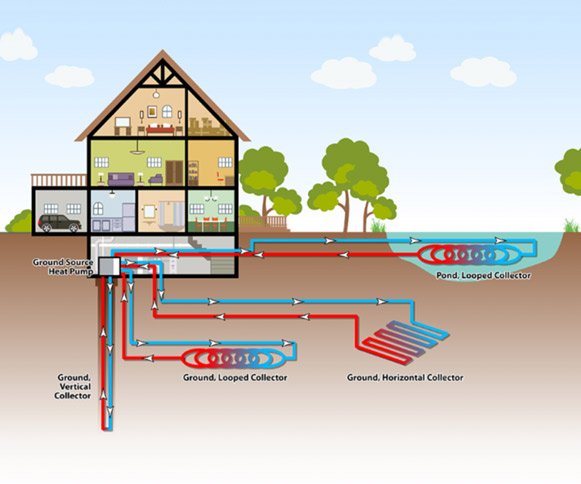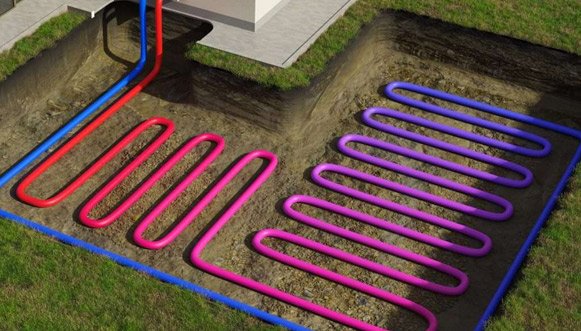Ground Source Heat Pump

Efficient Heating with Ground Source Heat Pumps
A major renewable source of heat can actually be found in the ground. The heat in the ground remains fairly constant in the UK, even through the winter months, producing small amounts of constant warmth. One of the best methods of extracting and harnessing this valuable energy is a Ground Source Heat Pump. Ground Source Heat Pump (GSHP) harness heat stored underground to provide your home with space heating and hot water. It is also called a ground-to-water heat pump. GSHP replaces a Gas, Oil or LPG boiler in a central heating system, but use ambient heat from the ground instead of burning fossil fuels.
You need some electricity to power a GSHP but the UK grid electricity increasingly comes from renewable sources. When the grid is completely decarbonised which is planned for 2035, all electric heating, including heat pumps, will be zero carbon.
Pipes are buried in the earth outside your house or boreholes are drilled and a mixture of water and antifreeze is circulated around them. The ground heat gets absorbed into the surrounding mixture and is transported to a heat exchanger and from there into the GSHP that passes it to the heating sources in your home, such as under floor heating and radiators. The GSHP works as a continuous process with the mixture circulating back down into the ground to absorb more energy once it has been used to heat your property.
There are some different types of GSHPs which can either extract the heat from earth or water. A closed loop system is the most common, using a contained water and antifreeze mixture. An open loop system uses water from the surrounding area but this needs to meet certain requirements such as being low in chlorine. Whatever type of GSHP you install, it is important that the system is correctly sized for your heating requirements.
Your house needs to be well insulated. The GSHPs produce heat at much lower temperatures than normal heating systems so you would be well advised to have sufficient floor, wall cavity and loft insulation as well as double glazing, to make sure all that heat is retained and you enjoy ambient temperature all year round.
If you are considering switching to a heat pump, an Air Source Heat Pump is the most obvious choice for most homes because they are much cheaper to install than the GSHP and do not require much space.

Harness the Power Beneath Your Feet
Sustainable Home Heating with Ground Source Heat Pumps
Frequently asked questions (FAQs)
GSHP use pipes containing thermal transfer fluid which is a mixture of water and biodegradable anti-freeze, also known as the ‘brine’ to absorb the naturally occurring thermal energy stored in the ground. The warmed brine circulates back to the GSHP, where a compressor increases its temperature. A heat exchanger then transfers the heat to radiators, underfloor heating and storage cylinders to provide heating and hot water.
Size of the ground loop will depend on the size of your home and how much heat you need. You may need more space if your home is larger or is an older property with lower levels of insulation. A flat array of pipes can be buried in trench about 1.2m deep throughout your garden, but vertical one can be laid down with borehole about 150m deep and 20cm diameter. A larger array buried in the ground helps to produce more heat but if space is limited, a vertical borehole can be drilled down into the earth. Your garden, or other area of land, must be accessible for digging machinery and the ground loop area must be clear of tree roots. It will largely also depend on how much land you have and the local geology. This is usually more expensive than digging trenches and usually needs a specialist ground (thermogeological) survey.
Installation of a GSHP is usually considered Permitted Development, so you do not require Planning Permission. However, if you live in a conservation area or a listed building, you should contact your Council to check on local requirements. GSHP operate quietly and as the unit is inside your home, there is no noise impact on neighbouring properties and there is normally no visual change to the exterior of your home.
In England and Wales, you can get £7,500 towards upfront costs for installation of a GSHP under the Boiler Upgrade Scheme (BUS). You do not have to pay this money back to the Government.
Let’s connect today
Have a query or need expert guidance on renewable energy solutions? Our friendly team is here to help so contact us and let’s build a greener future together.
SEND US A MESSAGE
CONTACT INFORMATION
Do you have questions about our services & solutions? Send us an email and we’ll get in touch shortly.
Follow Us
Connect with us to discover the latest in green energy, expert tips and exclusive offers. It only takes a second to stay informed and power your home sustainably!





